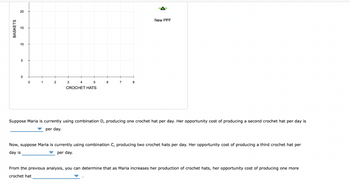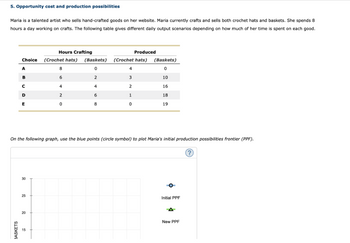
ENGR.ECONOMIC ANALYSIS
14th Edition
ISBN: 9780190931919
Author: NEWNAN
Publisher: Oxford University Press
expand_more
expand_more
format_list_bulleted
Question

Transcribed Image Text:BASKETS
20
15
10
5
0
0
1
2
3
5
CROCHET HATS
7
8
New PPF
Suppose Maria is currently using combination D, producing one crochet hat per day. Her opportunity cost of producing a second crochet hat per day is
per day.
Now, suppose Maria is currently using combination C, producing two crochet hats per day. Her opportunity cost of producing a third crochet hat per
day is
per day.
From the previous analysis, you can determine that as Maria increases her production of crochet hats, her opportunity cost of producing one more
crochet hat

Transcribed Image Text:5. Opportunity cost and production possibilities
Maria is a talented artist who sells hand-crafted goods on her website. Maria currently crafts and sells both crochet hats and baskets. She spends 8
hours a day working on crafts. The following table gives different daily output scenarios depending on how much of her time is spent on each good.
Hours Crafting
Produced
Choice (Crochet hats) (Baskets) (Crochet hats) (Baskets)
0
0
10
16
18
19
BASKETS
A
B
с
D
E
30
25
20
8
6
15
4
2
0
2
4
8
On the following graph, use the blue points (circle symbol) to plot Maria's initial production possibilities frontier (PPF).
4
3
2
1
0
Initial PPF
⠀3
New PPF
Expert Solution
This question has been solved!
Explore an expertly crafted, step-by-step solution for a thorough understanding of key concepts.
This is a popular solution
Trending nowThis is a popular solution!
Step by stepSolved in 4 steps with 1 images

Knowledge Booster
Learn more about
Need a deep-dive on the concept behind this application? Look no further. Learn more about this topic, economics and related others by exploring similar questions and additional content below.Similar questions
- Amy and Bill are fixing up their house by painting walls and installing electrical outlets. In one hour, Amy can paint 8 walls, or install 6 outlets. In one hour, Bill can paint 5 walls, or install 5 outlets In order to maximize their work per hour, (Click to select) should just paint walls, and (Click to select) ♥ should just install outletsarrow_forwardSuppose that Verania and Josimar are roommates that need to complete some household chores. Vacuuming and washing dishes need to be done. They know from the last time they did these chores that it takes Verania 2 hours to vacuum and 1 hour to wash dishes. It takes Josimar 3 hours to vacuum and 2 hours to wash dishes. Josimar says it does not matter which task each of them performs because Verania is faster at both tasks. Josimar’s reasoning a. is wrong. Because Verania has a comparative advantage in washing dishes, she should wash dishes, and Josimar should vacuum. b. is correct. Because Verania is faster at both tasks, there is no benefit in each volunteer specializing in one task or the other. c. is wrong. Because Verania has an absolute advantage in both tasks, she should perform both tasks herself. d. is wrong. Because Josimar has a comparative advantage in washing dishes, he should wash dishes, and Verania should vacuum.arrow_forwardAssume an economy producing only two goods (shoes and computers) with a fixed amount of productive resources and technology and employing all its productive resources to the maximum.Production in this economy is subjected to the law of diminishing marginal returns and resourcesare assumed to be fully optimized. In addition, the cost of sacrificing shoes for computers andvice versa is 1. On the basis of the foregoing assumptions, answer the following questions: Assume now that the sacrifice ratio is greater than 1, show what will happen to the shape of the production possibility frontier.arrow_forward
- Anation with fixed quantities of resources is able to produce any of the following combinations of carpet and carpet looms Production Possibility Frontier Yards of carpet (Millions) Carpet looms (Thousands) 43 75 60 20 45 35 30 45 15 50 50 24- These figures assume that a certain number of previously produced looms are available in the current period for producing carpet. 1.) Using the multipoint curve drawing tool, plot the six points that make up the PPF given in the table above (with carpet on the vertical axis). Properly label your curve. Carefully follow the instructions above and only draw the required object. 45 Carpet (millions) 15 30 60 75 (spuesnou) suoo| jade)arrow_forwardA pizza shop sells two types of pizzas: Chicago-style and New York-style. The owner makes $8.00 Profit on each Chicago- style pizza pie & $5.50 Profit on each New York-style pizza pie. The owner would love to sell an unlimited amount of pizza but unfortunately they are limited by two production constraints: Prep Time and Cook Time. Each Chicago-style pizza requires 4 minutes of Prep Time, each New York-style pizza requires 3 minutes of Prep time, and there is only 600 minutes of Prep Time available. Each Chicago-style pizza requires 5 minutes of Cook Time, each New York-style pizza requires 2.5 minutes of Cook Time, and there is only 550 minutes of Cook Time available. Based on the profit contributions & constraints given in the information above, what is the pizza shop's expected profit if it produces at the optimal amount? $800 $1120 $1560 $1100 O $1320arrow_forwardSuppose Nicholas owns a business making Christmas tree ornaments. Currently, he makes 300 ornaments a month. At this level of production, each additional ornament takes him 30 minutes to make and costs him $5 in materials. Nicholas makes his ornaments in a small studio that he rents for $300 a month. Nicholas can easily increase or decrease the amount of time he spends making ornaments, and he can easily go to the store to buy additional materials to make the ornaments, but he has a year-long lease on his studio, so he has to pay his monthly rent no matter how many ornaments he produces each month. Nicholas values his time at $10 per hour. Other than his time, the cost of the materials and the rent on his studio, Nicholas has no additional production costs. a At Nicholas's current level of production, what is the marginal cost of making an additional ornament each month? b. At Nicholas's current level of production, what is the monthly average fixed cost of each ornament? c. Assuming…arrow_forward
- QUESTION 2 After receiving an impressive commendation following a project, Ash realised the key to her inspiration and success was eating goji berries before starting her work. Ash can buy any number of kilograms of berries for $20 per kilogram. Ash gains a total benefit of $50 from consuming 2 kilograms of berries, and a total benefit of $65 from consuming 3 kilograms of berries. Which of the following statement(s) are true: There is insufficient information to determine the marginal cost of the third kilogram of berries. The average benefit of consuming the third kilogram of berries is $15. Ash should buy the third kilogram of berries because the marginal cost is less than the marginal benefit. The marginal benefit of consuming the third kilogram of berries is $15.arrow_forwardA company that produces brass hardware for doors has the ability to produce up to 6,500 hinges per week but then is unable to produce doorknobs. Or it can produce up to 650 doorknobs per week but then is unable to produce any hinges. In the graph below, use the straight-line tool to draw the company's production possibilities frontier, where the quantities are per week (do not use the point tool to plot endpoints). Then use the point tool to plot a point to indicate the company's maximum output where it is producing exactly three times as many hinges as doorknobs. To refer to the graphing tutorial for this question type, please click here. Quartity ofinge 000 7500 000 4000 000 100 1000 Quartity of doorknotarrow_forwardConsider Babs and Donna, who can each produce cake, beer, or some combination of the two using only 40 hours of labor each. Babs can produce a maximum of 50 cakes if she produces no beer, and 100 units of beer if she produces no cake. Donna can produce a maximum of 100 cakes with no beer produced; if she makes no cake, she can produce 120 units of beer. Calculate donnas opportunity cost for a cakearrow_forward
- In the aftermath of a hurricane, an entrepreneur took a one-month leave of absence (without pay) from her $5,000 per month job in order to operate a kiosk that sold fresh drinking water. During the month she operated this venture the entrepreneur paid the government $2,500 in kiosk rent and purchased water from a local wholesaler at a price of $1.38 per gallon. If consumers were willing to pay $2.12 to purchase each gallon of fresh drinking water, how many units did she have to sell in order to turn an economic profit? Instruction: Enter your responses rounded up to the nearest gallon.arrow_forwardA farmer can produce 10,000 pears (X) on his one-acre farmland, and when he uses the same land for apple cultivation, a total of 5,000 apples (Y) can be produced. He realizes that with the introduction of a new fertilizer, he can increase the maximum production of apples to 7,000. The maximum production of pears, however, remains unchanged. Hence, his new PPF equation is?arrow_forward
arrow_back_ios
arrow_forward_ios
Recommended textbooks for you

 Principles of Economics (12th Edition)EconomicsISBN:9780134078779Author:Karl E. Case, Ray C. Fair, Sharon E. OsterPublisher:PEARSON
Principles of Economics (12th Edition)EconomicsISBN:9780134078779Author:Karl E. Case, Ray C. Fair, Sharon E. OsterPublisher:PEARSON Engineering Economy (17th Edition)EconomicsISBN:9780134870069Author:William G. Sullivan, Elin M. Wicks, C. Patrick KoellingPublisher:PEARSON
Engineering Economy (17th Edition)EconomicsISBN:9780134870069Author:William G. Sullivan, Elin M. Wicks, C. Patrick KoellingPublisher:PEARSON Principles of Economics (MindTap Course List)EconomicsISBN:9781305585126Author:N. Gregory MankiwPublisher:Cengage Learning
Principles of Economics (MindTap Course List)EconomicsISBN:9781305585126Author:N. Gregory MankiwPublisher:Cengage Learning Managerial Economics: A Problem Solving ApproachEconomicsISBN:9781337106665Author:Luke M. Froeb, Brian T. McCann, Michael R. Ward, Mike ShorPublisher:Cengage Learning
Managerial Economics: A Problem Solving ApproachEconomicsISBN:9781337106665Author:Luke M. Froeb, Brian T. McCann, Michael R. Ward, Mike ShorPublisher:Cengage Learning Managerial Economics & Business Strategy (Mcgraw-...EconomicsISBN:9781259290619Author:Michael Baye, Jeff PrincePublisher:McGraw-Hill Education
Managerial Economics & Business Strategy (Mcgraw-...EconomicsISBN:9781259290619Author:Michael Baye, Jeff PrincePublisher:McGraw-Hill Education


Principles of Economics (12th Edition)
Economics
ISBN:9780134078779
Author:Karl E. Case, Ray C. Fair, Sharon E. Oster
Publisher:PEARSON

Engineering Economy (17th Edition)
Economics
ISBN:9780134870069
Author:William G. Sullivan, Elin M. Wicks, C. Patrick Koelling
Publisher:PEARSON

Principles of Economics (MindTap Course List)
Economics
ISBN:9781305585126
Author:N. Gregory Mankiw
Publisher:Cengage Learning

Managerial Economics: A Problem Solving Approach
Economics
ISBN:9781337106665
Author:Luke M. Froeb, Brian T. McCann, Michael R. Ward, Mike Shor
Publisher:Cengage Learning

Managerial Economics & Business Strategy (Mcgraw-...
Economics
ISBN:9781259290619
Author:Michael Baye, Jeff Prince
Publisher:McGraw-Hill Education